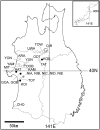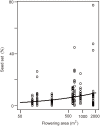Clonal structure, seed set, and self-pollination rate in mass-flowering bamboo species during off-year flowering events
- PMID: 25115953
- PMCID: PMC4130643
- DOI: 10.1371/journal.pone.0105051
Clonal structure, seed set, and self-pollination rate in mass-flowering bamboo species during off-year flowering events
Abstract
Bamboos are typical examples of highly synchronized semelparous species. Their mass-flowering events occur at supra-annual intervals but they sometimes flower on a small scale in off-years. If some bamboo ramets (culms) of a genet flower and die in off-years, whereas other culms of the same genet do not flower synchronously, the genet can still survive blooming in an off-year and could participate in the next mass-flowering event. At genet level, the effect might be similar to that achieved by synchronously reproducing iteroparous plants. In addition, if multiple genets flower simultaneously in off-years, cross-pollination will be promoted. However, it is not known whether all the culms in a genet flower synchronously and whether multiple genets flower in off-years. We determined the clonal structure of three temperate dwarf bamboo species, i.e., Sasa senanensis, S. kurilensis, and S. palmata, at 24 off-year flowering sites and the surrounding areas in northern Japan using seven microsatellite markers. We also estimated seed set at seven of the sites and self-pollination rates at five sites to determine off-year reproductive success. Next, we investigated whether seed sets at the culm level were related to flowering area and/or number of flowering genets, using generalized linear mixed-effect models (GLMMs). Multiple genets flowered at 9/24 flowering sites. We found that 40/96 of the genets identified had some flowering culms. Non-flowering culms were present in 24/40 flowering genets. Seed set was in the range 2.2%-12.5% and the self-pollination rate was 96.3%. In the best GLMM, seed set increased with flowering area. Seeds were produced in off-years, but cross-pollination was rare in off-years. We suggest that some dwarf bamboos may exhibit iteroparity or imperfectly synchronized semelparity at the genet level, a characteristic similar to that of other reproductively synchronous plants. We also found synchronous flowering of a few genets even in off-years.
Conflict of interest statement
Figures


Similar articles
-
Genets of dwarf bamboo do not die after one flowering event: evidence from genetic structure and flowering pattern.J Plant Res. 2009 Sep;122(5):523-8. doi: 10.1007/s10265-009-0241-9. Epub 2009 May 22. J Plant Res. 2009. PMID: 19462156
-
Female and male fitness consequences of clonal growth in a dwarf bamboo population with a high degree of clonal intermingling.Ann Bot. 2014 Oct;114(5):1035-41. doi: 10.1093/aob/mcu176. Epub 2014 Sep 15. Ann Bot. 2014. PMID: 25228034 Free PMC article.
-
Clonal structure and flowering traits of a bamboo [Phyllostachys pubescens (Mazel) Ohwi] stand grown from a simultaneous flowering as revealed by AFLP analysis.Mol Ecol. 2004 Jul;13(7):2017-21. doi: 10.1111/j.1365-294X.2004.02197.x. Mol Ecol. 2004. PMID: 15189222
-
Flowering of Woody Bamboo in Tissue Culture Systems.Front Plant Sci. 2017 Sep 14;8:1589. doi: 10.3389/fpls.2017.01589. eCollection 2017. Front Plant Sci. 2017. PMID: 28959269 Free PMC article. Review.
-
Longevity of clonal plants: why it matters and how to measure it.Ann Bot. 2010 Dec;106(6):859-70. doi: 10.1093/aob/mcq191. Epub 2010 Sep 29. Ann Bot. 2010. PMID: 20880935 Free PMC article. Review.
Cited by
-
Genet dynamics of a regenerating dwarf bamboo population across heterogeneous light environments in a temperate forest understorey.Ecol Evol. 2018 Jan 8;8(3):1746-1757. doi: 10.1002/ece3.3793. eCollection 2018 Feb. Ecol Evol. 2018. PMID: 29435249 Free PMC article.
-
Research on Key Genes for Flowering of Bambusaoldhamii Under Introduced Cultivation Conditions.Genes (Basel). 2025 Jul 11;16(7):811. doi: 10.3390/genes16070811. Genes (Basel). 2025. PMID: 40725467 Free PMC article.
-
Seed Set and Natural Regeneration of Dendrocalamus membranaceus Munro after Mass and Sporadic Flowering in Yunnan, China.PLoS One. 2016 Apr 14;11(4):e0153845. doi: 10.1371/journal.pone.0153845. eCollection 2016. PLoS One. 2016. PMID: 27077651 Free PMC article.
-
Delayed Flowering in Bamboo: Evidence from Fargesia qinlingensis in the Qinling Mountains of China.Front Plant Sci. 2016 Feb 16;7:151. doi: 10.3389/fpls.2016.00151. eCollection 2016. Front Plant Sci. 2016. PMID: 26909094 Free PMC article.
-
Mixed mating system and variable mating patterns in tropical woody bamboos.BMC Plant Biol. 2019 Oct 11;19(1):418. doi: 10.1186/s12870-019-2024-3. BMC Plant Biol. 2019. PMID: 31604418 Free PMC article.
References
-
- Ims RA (1990) The ecology and evolution of reproductive synchrony. Trends Ecol Evol 5: 135–140. - PubMed
-
- Lloyd M, Dybas HS (1966) The periodical cicada problem. I. Population ecology. Evolution 20: 133–149. - PubMed
-
- Koenig WD, Mumme RL, Carmen WJ, Stanback MT (1994) Acorn production by oaks in central coastal California: Variation within and among years. Ecology 75: 99–109.
-
- Janzen DH (1976) Why bamboos wait so long to flower. Ann Rev Ecol Sys 7: 347–391.
-
- Janzen DH (1971) Seed predation by animals. Ann Rev Ecol Sys 2: 465–492.
Publication types
MeSH terms
Substances
LinkOut - more resources
Full Text Sources
Other Literature Sources

